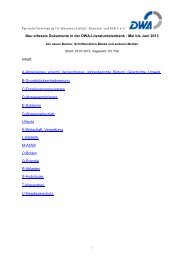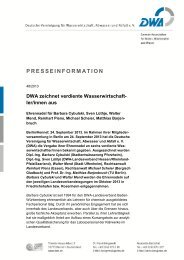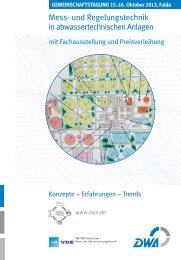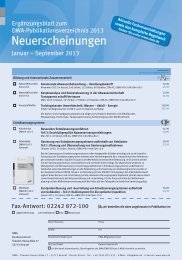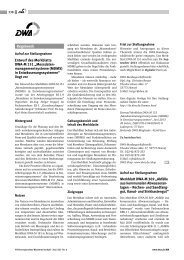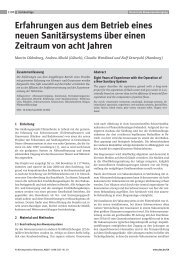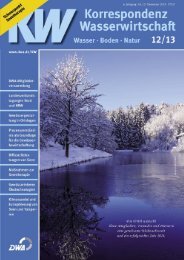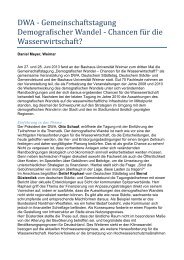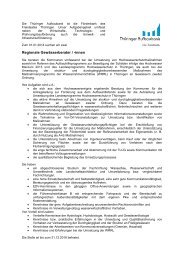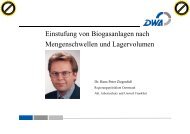Forschungsprojekte Anthropogene Spurenstoffe - DWA
Forschungsprojekte Anthropogene Spurenstoffe - DWA
Forschungsprojekte Anthropogene Spurenstoffe - DWA
Sie wollen auch ein ePaper? Erhöhen Sie die Reichweite Ihrer Titel.
YUMPU macht aus Druck-PDFs automatisch weboptimierte ePaper, die Google liebt.
<strong>Forschungsprojekte</strong> zu anthropogenen <strong>Spurenstoffe</strong>n im Wasserkreislauf<br />
which were enacted by the Federal Biological Research Centre for Agriculture and Forestry<br />
(Biologische Bundesanstalt für Land- und Forstwirtschaft, BBA) in order to reduce the spray<br />
drift input into surface waters, are hardly obeyed by the farmers. Nevertheless, control<br />
measures are seldom carried out because neither the number of personnel of the authorities<br />
nor their inspection strategies are sufficient.<br />
Recently, the regulations of pesticide application NW 700 ff. and NW 800 for the two<br />
pathways of entry „runoff“ and „tile drainage“, were enacted. However, it can be expected<br />
that there will be considerable shortcomings in the enforcement of these regulations for the<br />
same reasons as stated above.<br />
Comparatively, experience shows that only minor implementation shortcomings in the<br />
storage of pesticide products and in the preparation of spray solution are to be expected. For<br />
both processes it is in the users’ best interest to work carefully and prevent a loss of pesticide<br />
products. With respect to groundwater, available information suggests that the following of<br />
the Code of Best Management Practice was improved in the past through advisory and control<br />
measures. Recently, the regulations of pesticide application NW 467 and NW 468 were<br />
enacted against pesticide input into surface waters from farmyard waste waters caused by<br />
sprayer cleaning and disposal of remaining sprayer solution into the farmyard drain. The<br />
effectiveness of these regulations of pesticide application cannot be estimated at the moment.<br />
For the moderate to inadequate implementation of the pesticide application provisions, there<br />
are three primary causes:<br />
1. The capabilities of the personnel of the controlling authorities are completely<br />
insufficient when related to the immense number of needed inspections.<br />
2. The provisions for pesticide application are action-oriented. In contrast to technical<br />
standards, no effective control strategies exist for action-oriented provisions. The<br />
carrying through of norms could be improved in most areas of pesticide application if<br />
the emphasis was shifted to really practical provisions, such as the intensification of<br />
the controlling of sprayer equipment.<br />
3. As a result of the lack of personnel, official advisory services are drastically reduced,<br />
and the environmental extension services aren’t often offered. The good relations<br />
between the advisory personnel and the farmers should be encouraged to improve<br />
environmental concerns.<br />
In the future pesticide users will be increasingly contacted and advised by the commercial<br />
advisory services of the farmers association and by the pesticide producers themselves. It is in<br />
the best interest of the commercial advisory organisations to work in a supplementary fashion<br />
with the official.<br />
S auch Datei (UBA-Texte_43_99_Pflanzenschutzmittel_Kurzfassung.pdf)<br />
Bewertung<br />
55



